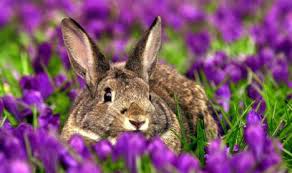
Feeding and Housing
After choosing the right breed of fiber rabbit and learning the grooming needs of each breed, it is now time to consider safe housing and healthy diet requirements. Fiber rabbits will require a sturdy, clean environment to live. They will also need a proper diet to maintain their health, which in turn results in a beautiful coat. This coat will give you premium fiber for your spinning and creating.

Feeding Your Rabbits
A rabbit’s digestive system is built to break down cellulose, in the form of woody stems and fibrous vegetation. Hay is a great form of fiber for their system. It can come in raw forms or pellets. In the wild, a rabbit would eat grass( dried grass=hay), which contains vitamins, proteins and minerals for their needs. Therefore offering hay freely is important. You will need to offer fresh vegetable 2 times a day. Amounts will vary depending on size and breed. I usually offer my rabbits carrots, lettuce and in summer, fresh greens I pick especially for them. Mine love dandelions, plantain leaves, clover and just plain grass. There is some controversy regarding if formed pellets give the same nutritional and gut benefits as hay and grasses. I will leave that to the experts. It is important to ask the breeder you buy from, what their regime has been. It is best to keep them on what they are use to. If adjustments need to be made, it can be done slowly to allow their body’s to get used to it. Unlimited fresh water is also necessary.

Rabbit Housing
Even though rabbits are smaller than most house pets, they require room to move and get exercise which is important for overall health and digestion. Many rabbit houses I have seen have wire mesh bottoms. This is convenient for cleaning, but not meant for your rabbit’s feet which are not padded. If you choose to use wire mesh you must also provide a flat firm surface they can go to. It is important to note, rabbit’s will use a litter box! If you chose mesh because you are concerned with cleaning needs, you don’t have to. They will willingly use the box. To measure what size cage you will need, measure your rabbit as he/she is stretched out. Now multiply that by 6 to have a general idea of footage. Then you need to consider an exercise area if your rabbits do not have a dedicated outside run. Twenty four square feet of exercise space is recommended for 1-2 rabbits. Rabbits can be supervised, leash trained or in a designated enclosure for exercise. House rabbits can have free time outside the cage. Their enclosure should be their safe place. I have a small “house” within the cage for them to hide/sleep/hang out as they choose. It gives them cover and a safe place to hide if they are scared. I use a large dog crate with full tray bottom. I have shavings for the “bathroom area” and hay for bedding. The shavings absorb wetness and odor and the hay gives them a softness to “nest” and a snack! Win win. My buns will take hay and burrow under it to form a tunnel. I use the outside run for exercise when weather cooperative. The UTMOST important consideration for housing is safety. If your rabbits are in an outside enclosure, you MUST be sure they are protected from predators. Mine are in a closed building with secure door closures and buried barrier around perimeter. We also have the added protection of an electric fence because we have bears in our area and they can smell feed a mile away!
My Dickens is near 10 years old and although that is on the average end of life span, he seems happy and healthy with the life I have provided for him. I love it when he sees me coming and pushes his nose through the wire to see what treats he is getting. He has spunk and personality. Rabbits can be a great addition to your homestead, family or fiber farm with little requirements and lots of reward.
